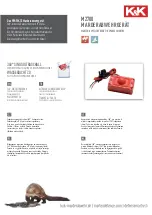
Over Voltage adjustment
The AVR includes protection circuitry to remove generator
excitation in the event of an over-voltage on the AVR
terminals. Separate terminals are provided for the overvoltage
sensing circuit (E3, E4). The shut-down signal acts on the
AVR power output device.
Provision is made for the optional connection of a miniature
circuit breaker to break terminals K1, K2, which cuts off the
excitation power directly. This provides extra protection in the
event of a malfunction of the AVR power output device.
The trip coil on the circuit breaker connects to the AVR which
provides a trip signal to energise the coil in the event of an
over-voltage.
The over-voltage adjustment is set and sealed at the factory
but can be reset on retrofit AVRs. Clockwise rotation of the O
/ V adjustment increases the voltage trip level. An over
voltage trip condition is indicated by a flashing red LED (which
also indicates over excitation trip). The generator must be
stopped to reset an over voltage trip condition.
Over excitation adjustment
The adjustment is set and sealed in the works and should not
be altered. The shut-down signal acts on the AVR power
output device.
Provision is made for the optional connection of a miniature
circuit breaker to break terminals K1, K2, which cuts off the
excitation power directly. This provides extra protection in the
event of a malfunction of the AVR power output device.
The trip coil on the circuit breaker connects to the AVR which
provides a trip signal to energise the coil in the event of an
over-excitation condition.
An over excitation condition is indicated by a flashing red LED
(which also indicates over voltage trip). The generator must
be stopped to reset an over excitation trip condition.
Ramp adjustment
The AVR includes a soft start or voltage ramp-up circuit to
control the rate of voltage build up when the generator runs
up to speed. This is normally pre-set and sealed to give a
voltage ramp-up time of approximately 3 seconds. If required,
this can be adjusted between the limits defined in the
specification.
Sometimes this feature is useful for starting large motors or
energising large transformers. The technique is to run the
generator up to speed with AVR terminals K1 K2 operated by
a normally open relay (240v dc 10A rating). When the relay is
closed, the voltage will build up smoothly over time, keeping
the load surge currents to a minimum.
PWL
This adjustment controls the Pulse Width Limit of the AVR
power output device and controls the maximum excitation that
the AVR can deliver. This is pre-set to deliver the required
short circuit current for the generator and should not be
altered.
Mode and Hand
These controls are for service engineers use only and should
not be tampered with. They allow the excitation to be
controlled manually.
TD_MA327.GB_09.02_01
PO Box 17 • Barnack Road • Stamford • Lincolnshire • PE9 2NB
Tel: 00 44 (0)1780 484000 • Fax: 00 44 (0)1780 484100
Website: www.newage-avkseg.com
© 2002 Newage International Limited.
Reprinted with permission of N.I. only.
Printed in England.
























